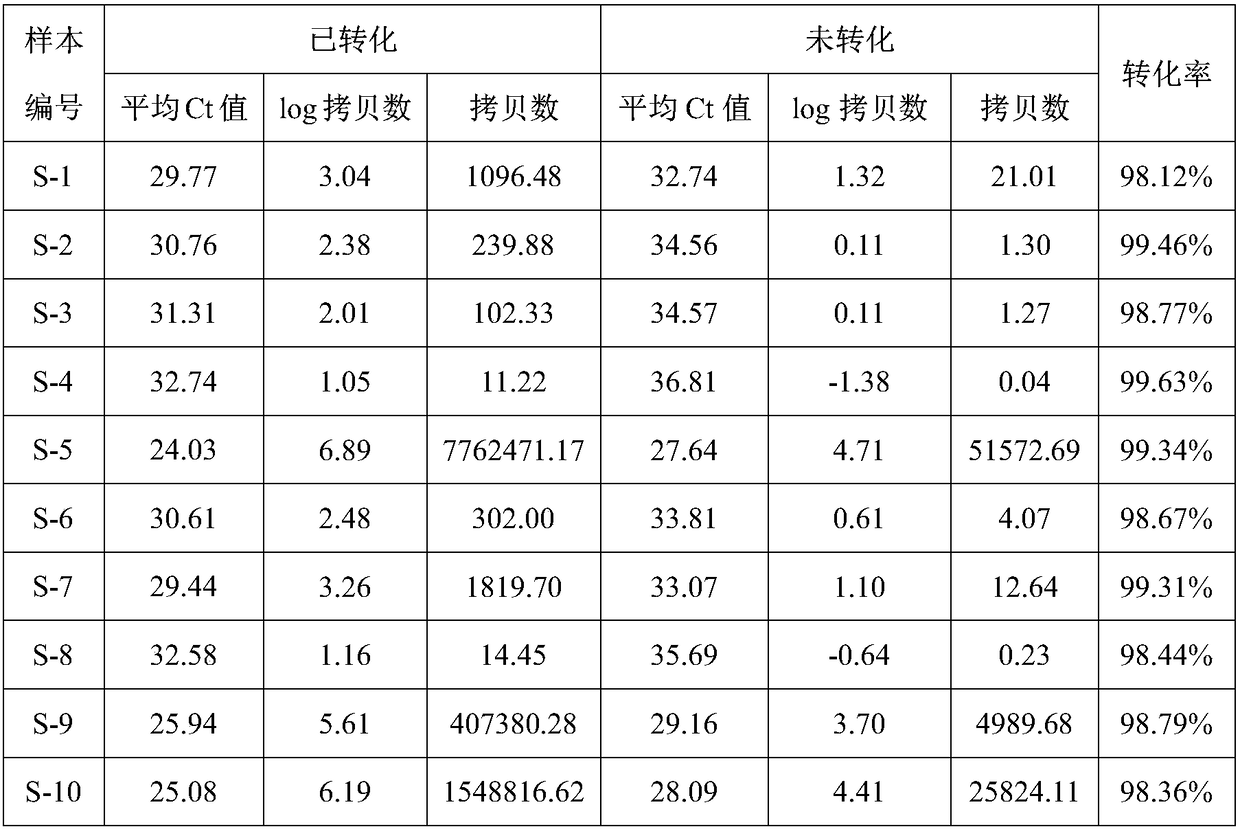Method for directly converting plasma into hydrosulfite and application thereof
A technology of bisulfite and plasma, applied in the field of molecular biology research, can solve the problems of cumbersome operation steps, time-consuming, difficult automation, etc., and achieve the effect of avoiding DNA loss, simple operation, saving time and cost
- Summary
- Abstract
- Description
- Claims
- Application Information
AI Technical Summary
Problems solved by technology
Method used
Image
Examples
Embodiment 1
[0030] Example 1: Direct bisulfite conversion of plasma
[0031] Test materials: healthy human plasma samples, methylation positive plasma samples
[0032] Test equipment: magnetic frame, constant temperature oscillator, vortex mixer
[0033] Main reagents: sodium bisulfite, sodium metabisulfite, magnetic beads
[0034] The specific implementation steps are as follows:
[0035] 1. Bisulfite conversion: Add 1.0mL plasma, 1.2mL sample treatment solution, 30μL proteinase K and 180μL bisulfite solution (a mixture of sodium bisulfite and sodium pyrosulfite, the final concentration is 4.5mol / L), vortex to mix, and incubate at 50°C for 40min;
[0036] 2. DNA binding: Add 25 μL of magnetic beads and 300 μL of binding solution to the above reaction solution, vortex to mix, adjust the constant temperature oscillator to rotate at 800 rpm, and incubate at 20°C for 25 minutes. remove residual liquid;
[0037] 3. For the first wash: add 800 μL of rinse solution I, vortex to mix, centr...
Embodiment 2
[0041] Example 2: Evaluation of bisulfite conversion
[0042] In this example, taking the Septin9 gene as an example, the Taqman qPCR method was used to evaluate the conversion efficiency of bisulfite.
[0043] experiment procedure:
[0044] 1. Design of primers and probes
[0045] The primers and probes for bisulfite-converted and non-converted Septin-9 genes were designed respectively; primers and probes were designed for a sequence of GAPDH internal reference gene without CpG islands.
[0046] 2. PCR reaction system
[0047] The internal reference gene and the Septin-9 gene were reacted in the same reaction tube; each probe was labeled with a different fluorescent group to distinguish the internal reference gene and the Septin-9 gene.
[0048] The Septin-9 gene positive samples and negative samples verified by Sanger sequencing were respectively used as templates for PCR amplification.
[0049] 3. Construction of standard curve
[0050] Select 6 5-fold gradient dilutio...
PUM
 Login to View More
Login to View More Abstract
Description
Claims
Application Information
 Login to View More
Login to View More - R&D
- Intellectual Property
- Life Sciences
- Materials
- Tech Scout
- Unparalleled Data Quality
- Higher Quality Content
- 60% Fewer Hallucinations
Browse by: Latest US Patents, China's latest patents, Technical Efficacy Thesaurus, Application Domain, Technology Topic, Popular Technical Reports.
© 2025 PatSnap. All rights reserved.Legal|Privacy policy|Modern Slavery Act Transparency Statement|Sitemap|About US| Contact US: help@patsnap.com



